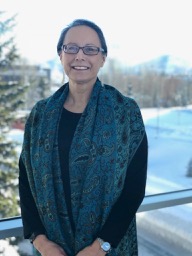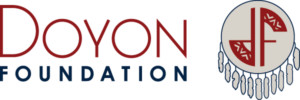“Native languages are important to all Alaskans”
 Beth Leonard is a professor at the University of Alaska Anchorage where she directs the Alaska Native Studies Program. She holds a doctorate in cross-cultural and Alaska Native studies in addition to degrees in linguistics and language and literacy. In 2014, she traveled to New Zealand as a Fulbright scholar.
Beth Leonard is a professor at the University of Alaska Anchorage where she directs the Alaska Native Studies Program. She holds a doctorate in cross-cultural and Alaska Native studies in addition to degrees in linguistics and language and literacy. In 2014, she traveled to New Zealand as a Fulbright scholar.
Her parents are James Dementi of Nenana/Shageluk and the late Jean Dementi, originally from Ventura, California. Her maternal grandparents are Charles and Ruth Aubrey of Ventura, California; her paternal grandparents are Charlie Dementi of Dishkaket and Lena Phillips Dementi of Shageluk.
Immediate family members include her husband, Michael Leonard; daughter, Samantha Jean Quinn, and son-in-law, Richard Quinn; and Jeanette Dementi, her father’s second wife, originally from Michigan.
“I didn’t learn Deg Xinag growing up, so I didn’t understand and appreciate my culture as much as I could have,” Beth says. “Language helps connect me with my immediate and extended family. It strengthens my identity as a Deg Xit’an person.”
Beth was in her early 30s when she began learning the language from her father, James Dementi. “He was very patient,” she recalls. The two recently worked together to contribute translations for a new Yukon-Kuskokwim Health Corporation building in Bethel. Elders who taught community-based language and cultural activities, sometimes including audioconferenced university courses, were also instrumental to her learning. These Elders included Raymond Dutchman, Hannah Maillelle, Katherine Hamilton, Louise Winkelman, Edna Deacon and Lucy Hamilton. Beth also learned from audio recordings of Belle Deacon of Grayling, Grace John of Shageluk, and others who were recorded during the 1970s Alaska Native Oral Literature Project.
“Because Alaska Native languages are so different from English, they’re often considered hard to learn,” Beth says. Learning to speak authentically can be a challenge; everyday activities may be expressed in several ways, so that some variations are more suited to certain situations or seasons than others.
“Fear of making mistakes has been among my biggest challenges,” Beth says.
She’s grateful for chances to learn with other language students and Elders: “I wish I’d learned more of the language as a younger person. Immersion programs, like those in Anchorage and Fairbanks, among other sites, are signs that young people are eager to learn Native languages.”
“I’m thankful for Elders and young people who take on this work,” she says. While administrative duties have limited her teaching lately, she’s eager to help guide efforts for Native language learning at the university level and beyond, including language revitalization work undertaken by some members of the Alaska Native Studies Council.
A class in Athabascan linguistics taught by Professor James Kari at the University of Alaska Fairbanks inspired Beth’s interest in learning Deg Xinag. His course and others introduced her to the history of ways that indigenous languages had been suppressed and marginalized. She went on to work with Alice Taff, a professor from the University of Alaska Southeast, who’s since retired. Alice contributed to a grammar of Deg Xinag and, with the help of educator Donna MacAlpine and several Elders, developed a Deg Xinag online dictionary. More recently, Alice and Donna recorded stories by Hannah Maillelle, Ellen Savage and Edna Deacon, available through a University of Alaska Southeast website.
Instrumental work in Deg Xinag has been done by many community members and educators, including Malinda and Marilyn Chase of Fairbanks/Anvik, George Holly of Soldotna/Holy Cross, and Jeanette Dementi, who helped translate the Lord’s Prayer and developed language-learning games, songs and other materials. Jeanette also recorded Beth’s father’s story about butchering a moose.
Sonta Hamilton Roach from Shageluk and Dr. LaVerne Demientieff from Fairbanks/Holy Cross have been active most recently in Deg Xinag language teaching initiatives, including facilitating the “Where Are Your Keys” method. LaVerne also began hosting a telephone language learning group in fall 2018.
Immersion methods of language learning, along with listening to recorded stories and conversations, are useful strategies for Beth because she’s not distracted by writing. “I found that I became too dependent on the writing system when I should have been developing my listening skills,” she says. For language learning, active listening can help with memorizing and pronunciation.
“Native languages are important to all of us Alaskans, as they carry thousands of years of knowledge and wisdom,” Beth says, adding that the languages embody worldviews that contrast with Western ways.
Virtues such as respect and reciprocity and the importance of right relationships are a foundation for many indigenous peoples in the way they speak about – and with – other people, the land and waters, and other beings that share the world. “These values are carried through Alaska Native languages in complex, academic ways,” Beth says.
As Doyon Foundation continues to grow our language revitalization efforts in the Doyon region, we would like to recognize people who are committed to learning and perpetuating their ancestral language. We are pleased to share some of these “Language Champion” profiles with you. If you know a language champion, please nominate him or her by contacting our language program director at haytona@doyon.com. Language champions may also complete our profile questionnaire here. You may learn more about our language revitalization program on our website.
